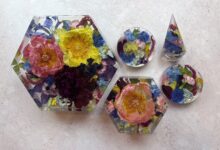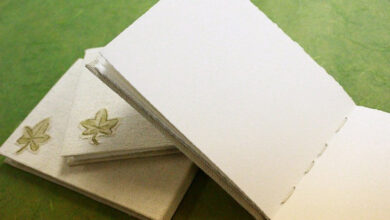The Fascinating World of BookBinding Materials
Hello Visitors, as bookbinders, we all know how important it is to have the right materials for the job. The materials used can make or break the book’s durability and quality. Today, we will be exploring the fascinating world of bookbinding materials and what makes them so essential. We will look into their strengths and weaknesses, frequently asked questions, and a table full of information to guide you in choosing the right materials.
Contents
- 1 Introduction
- 1.1 What are BookBinding Materials?
- 1.2 The Importance of BookBinding Materials
- 1.3 The Role of Bookbinding Materials
- 1.4 History of BookBinding Materials
- 1.5 Why Bookbinding Materials Keep Evolving
- 1.6 The Process of Choosing the Right BookBinding Materials
- 1.7 Why Cost Shouldn’t be the Sole Factor in Choosing BookBinding Materials
- 2 Strengths and Weaknesses of The Fascinating World of BookBinding Materials
- 3 BookBinding Materials Guide: A Table with Complete Information
- 4 Frequently Asked Questions (FAQ)
- 4.1 1. What is endpaper, and what is its importance in bookbinding?
- 4.2 2. Why is bookbinding leather expensive?
- 4.3 3. Is it possible to do bookbinding at home?
- 4.4 4. Can you get buckram in different colors and textures?
- 4.5 5. How long can a book last if the right bookbinding materials are used?
- 4.6 6. What is the difference between parchment and vellum?
- 4.7 7. What is the best glue to use for bookbinding?
- 4.8 8. Can bookbinding materials be recycled?
- 4.9 9. Can I use regular paper for making books?
- 4.10 10. What is the difference between case binding and perfect binding?
- 4.11 11. Are bookbinding materials environmentally friendly?
- 4.12 12. Can beginners use expensive bookbinding materials?
- 4.13 13. Is bookbinding worth it?
- 5 Conclusion
- 6 Disclaimer
Introduction
What are BookBinding Materials?
Bookbinding materials are essential elements used to bind books, and they vary depending on the desired outcome. They are selected based on their unique characteristics, including cost, durability, aesthetic appeal, and functionality. In bookbinding, materials range from the cover material to the adhesive used, thread, endpapers, and more.
The Importance of BookBinding Materials
Without proper bookbinding materials, books would be prone to damage from external factors such as humidity, wear and tear, and climate. With appropriate materials, books can have a longer lifespan while maintaining their aesthetic appeal, making them enduring treasures for generations to come. Moreover, using quality materials boosts the book’s overall value and comfort during handling, making it a practical and timeless possession.
The Role of Bookbinding Materials
It’s vital to note that bookbinding materials play significant roles in the creation of books. The adhesive used holds the book’s pages and cover together. The cover material adds personality and durability to the book. Thread used in sewing helps stitch the pages while endpapers protect the pages from glue and strengthen the spine.
History of BookBinding Materials
The history of bookbinding materials dates back to ancient times when books were handwritten manuscripts and were kept in parchment or leather binders. Throughout history, binding materials were made from various sources with some of the most common materials like parchment, leather, glue, and thread. Today, modern technology and innovation have brought forth a wide range of materials, each with its own unique composition that offers improved durability, aesthetics, and practicality.
Why Bookbinding Materials Keep Evolving
Bookbinding materials keep evolving due to the need to create and re-create materials that can match modern-day demands while maintaining quality. With the development of technology and science, there’s the potential to create materials that can offer better longevity and value compared to traditional ones. The need to adhere to environmental preservation laws has also inspired innovation to develop eco-friendly materials, which are greener, safer, and healthier for the user and the environment.
The Process of Choosing the Right BookBinding Materials
Choosing the right bookbinding materials depends on various factors. These factors include the type of book, the desired outcome, the target audience, the budget, and the level of expertise of the person doing the binding. Understanding these factors is critical in selecting the right bookbinding materials that will guarantee the desired success.
Why Cost Shouldn’t be the Sole Factor in Choosing BookBinding Materials
As much as the cost plays a crucial role in selecting bookbinding materials, it shouldn’t be the sole determining factor. The cost of the materials is relative to their durability, aesthetic appeal, functionality, and practicality. While costlier materials may initially seem more expensive, they offer long-term benefits and increased value to the book.
Strengths and Weaknesses of The Fascinating World of BookBinding Materials
Strengths
• Bookbinding materials ensure the durability and longevity of books.
• They enhance the aesthetic value of books.
• They help maintain the book’s functionality and practicality.
• They preserve books’ value over many years.
• They offer a way to personalize books.
Weaknesses
• Bookbinding materials can get expensive.
• Choosing the wrong bookbinding materials can ruin the book.
• Selecting the right materials can be time-consuming.
• Books become vulnerable when exposed to humidity, dust, and heat.
• Availability of some materials may pose a challenge in some regions.
BookBinding Materials Guide: A Table with Complete Information
| Bookbinding Material | Pros | Cons |
|---|---|---|
| Leather | Durable, Exquisite, Classic | Expensive, Not Vegan-friendly |
| Parchment | Ancient feel, Water-resistant, Unique | Needs Special Handling, Expensive |
| Vellum | Natural feel, Smooth, Durable | Expensive, Tendency to curl |
| Cloth | Affordable, Wide Range,Sturdy | Lacks Durability, May Not Stand Out |
| Japanese Paper | Flexible, Lightweight, Soft | Expensive, Fragile |
| Suede | Soft, Luxurious, Textured | Challenging to Clean, Expensive |
| Buckram | Sturdy, Easy to Access and Use | Not Aesthetic, May Lack Class |
| Foil-stamped Cloth | Aesthetically Pleasing, Durable | Costly, Limited Availability |
Frequently Asked Questions (FAQ)
1. What is endpaper, and what is its importance in bookbinding?
An endpaper is a double sheet glued to the book’s cover and the first or the last page. It protects the pages from glue and strengthens the spine. It also adds to the book’s aesthetic appeal and gives a finished look to a book.
2. Why is bookbinding leather expensive?
Leather is more expensive than other materials that can be used in bookbinding due to the long process of tanning. It takes longer for tanning compared to other materials and requires a higher level of craftsmanship and provides a unique look and texture.
3. Is it possible to do bookbinding at home?
Yes, you can do bookbinding at home. Basic bookbinding tools and techniques are readily available, affordable and is perfect for simple bookbinding projects.
4. Can you get buckram in different colors and textures?
Yes. Buckram comes in different colors, textures, widths, and lengths. Today, buckrams of different textures and patterns are available for bookbinding.
5. How long can a book last if the right bookbinding materials are used?
The lifespan of a book remains dependent on several factors, including the book’s storage condition, usage, and the frequency of handling. With proper bookbinding materials and storage conditions, books can last for an extended period, sometimes even centuries, while still maintaining their durability and aesthetic appeal.
6. What is the difference between parchment and vellum?
Parchment refers to animal skins that are partially or wholly processed to create a durable material used on books. On the other hand, Vellum is a finer and smoother writing surface made from high-quality animal skins that are entirely processed.
7. What is the best glue to use for bookbinding?
There’s no one-size-fits-all answer as different types of glue are good for specific types of bookbinding projects. PVA glue is the most commonly used glue in bookbinding projects, but a solvent-based glue also works well with leather bindings.
8. Can bookbinding materials be recycled?
Yes, Bookbinding materials can be recycled. Leather is biodegradable, whereas paper and cardboard can be recycled to make different products.
9. Can I use regular paper for making books?
Yes, you can use regular paper for making a book. However, using the right type of paper can make a significant difference in the book’s durability, lifespan, and aesthetic appeal.
10. What is the difference between case binding and perfect binding?
Case binding is a hardcover binding style where both the cover and pages are sewn together and glued to the spine. Perfect binding is a binding style where the pages and cover are glued together at the spine and wrapped with a single cover.
11. Are bookbinding materials environmentally friendly?
Yes, Bookbinding materials can be environmentally friendly. Eco-friendly materials like recycled paper and biodegradable leather-like cork or recycled rubber are now being produced to promote ecological preservation.
12. Can beginners use expensive bookbinding materials?
Yes, beginners can use expensive bookbinding materials, but it’s recommended to choose starter materials until the skillset improves. As one’s skill improves, one can start using more expensive materials.
13. Is bookbinding worth it?
Yes, bookbinding is worth it. The process offers a sense of pride and accomplishment and creates a connection with the materials and final product. Moreover, bookbinding offers longevity to books that deserve to last for many generations.
Conclusion
Bookbinding materials are essential elements that define the bookbinding process, determining the look, functionality, and durability of a book. Understanding the characteristics of different materials and the role they play is critical in choosing the right materials that will deliver the desired outcome. In this article, we’ve delved into the fascinating world of bookbinding materials and what makes them so essential. We’ve discussed their strengths and weaknesses, frequently asked questions, and highlighted a table full of information to assist you in selecting the right material. As a bookbinder or book enthusiast, choosing the right bookbinding material is vital to creating timeless and long-lasting books that will withstand the test of time.
Thanks for reading, and do not hesitate to explore other topics on our website.
Disclaimer
The content of this article is provided for informational purposes only and not a substitute for professional advice. Before starting any bookbinding project, please consult a bookbinding expert for guidance. We do not guarantee the accuracy, completeness, or reliability of any opinions or information contained herein.
Originally posted 2023-08-05 13:00:00.









